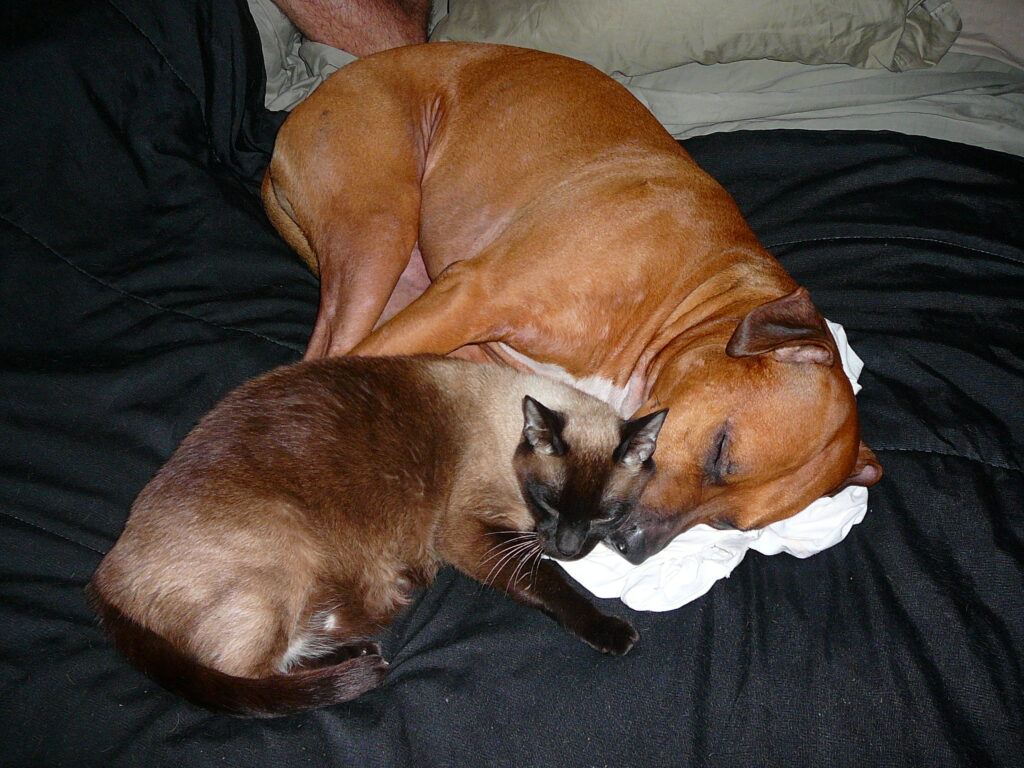Folklore about our most popular family pets spawned the saying, “fighting like cats and dogs.” Though skirmishes and at times serious battles can occur between them, such is not always the case. So, can a cat and a dog become friends? Can such a relationship become possible?

Here’s a story about how one such friendship developed: Some folks I know adopted a neighbor’s dog who was left behind when the family moved. These friends owned a big black cat. The first time the dog came in the house, the cat was lying on the kitchen floor.

Upon seeing the dog, the cat rose up on all four legs and ran at the dog, striking terror into the poor creature’s heart. The dog ran; the cat chased him, through the kitchen, the dining room, the living room, and finally cornered the dog, who was, by then, cowering and subdued.
After that one incident, no further conflicts followed. The dog and cat became friends, and happily shared their home together.
Sometimes the cat simply wishes the dog would disappear. Once, friends brought their dog when they came to visit. We all met in our little front porch. Our cat, who was already on the porch, took an immediate dislike to this new four-legged visitor.
Consequently, the cat jumped on the dog’s back, and that terrified animal raced around the little room trying to run out from under that cat. The owners finally took the dog outside. I can imagine that the cat rubbed his paws together in satisfaction.
Who Started The Conflict?
These two stories exemplify the latest findings by cat investigators. A cat is more likely to threaten a dog than the other way around. Unless a cat runs and a dog takes chase, it turns out that observations of dogs threatening cats were rare.

Why do cats find dogs threatening? I’m guessing that the most likely reason focuses on the size difference. The cat, probably the smaller of the two, must feel that it’s important to put that beast in its place right away, thus removing the possibility of a threat to kitty’s well-being.
If a cat and dog become acquainted at a young age, they are more likely to become friends. If they become acquainted when they are older, the stress factor between them becomes higher. If the cat moves in to a home before the dog, he might become more inclined to friendship.
Indoor cats seem to develop better relationships with dogs, possibly because the cat spends more time with other people and pets, and therefore doesn’t get as stressed by the dog. To help kitty deal with that dog, be sure to provide high places and secluded spots where only the cat can go. Feeling safe is vital.
Helping A Dog And A Cat To Accept Each Other
There are some guidelines to follow when introducing a dog and cat that might make their getting along a bit easier to develop. Just as when introducing any newcomer to the family circle, a dog and a cat should also go through an introduction process.
At first, keep them separated. Set up separate rooms for the animals until they get used to the other being there. Keep kitty in one room with everything he needs: scratching post, toys, food, water, and litter box. Give him plenty of attention.

Follow crate-training procedure with the new dog at first. During this time, give both the cat and the dog something that smells like the other, such as a blanket, so they can get used to the scent of the other, before meeting.
Keep the first meeting a quick one. The first time you introduce the two, it should last perhaps 10 minutes. Keep the dog leashed and let the cat roam free, coming as close to the dog as desired. Reward the dog with treats for calm behavior.
Gradually increase the time they spend together, as long as things are going well. Don’t rush things, as it could take weeks or even months before the two feel comfortable together.

Do a personality evaluation. If your cat has lived with dogs before and is at ease around other animals, perhaps the cat will adjust quickly to having the dog around. If the cat is aggressive, you’ll have a bit more of a difficult time.
What about your dog? Is he playful but not aggressive? If so, he may more easily adapt to a cat. If the dog lunges, growls, and in general becomes difficult to control, he may never be safe with your cat. In this case, you’ll need your vet’s advice.
It is important and indeed necessary to supervise. Until you become convinced that the two animals present no risk to each other, it’s safest to keep your dog in a crate. Even when playing, the dog can seriously injure a cat. It’s also vital that you prevent your dog from chasing your cat.
Make sure the cat has a safe place where the dog cannot go. You could provide a cat tree or a separate room with a cat door.
Use basic commands to keep your dog under control. Make sure the dog knows such basics as “leave it,” “sit,” or “stay.” Reward the dog with treats when he obeys your command. Exercise the dog; keep him very busy; then he will be less apt to wish to chase the cat.
Friendships Take Time To Develop

Just as with people, friendships between animals take some time to develop. Be patient; give both an equal amount of attention; allow them to learn slowly to accept each other. With luck, they will become good buddies. In such a case, their lives will become enriched.
References I used for this post:
petmd.com/cat/training/evr_ct_how-to-introduce-a-dog-to-a-cat fearfreepets.com/for-good-cat-dog-relationships-focus-on-the-cat-study-suggests/ petinsurance.com/healthzone/ownership-adoption/pet-ownership/pet-behavior/dog-and-cat-relationships/ psychologytoday.com/us/blog/all-dogs-go-to-heaven/201807/how-well-do-dogs-and-cats-really-get-along

